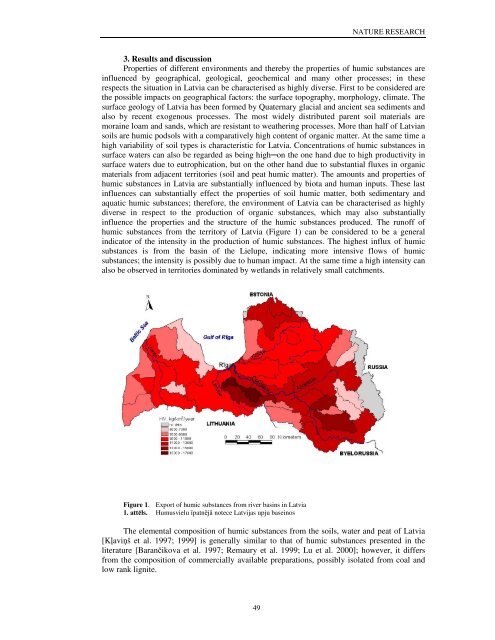Folia Geographica 10. sÄjums - Latvijas UniversitÄte
Folia Geographica 10. sÄjums - Latvijas UniversitÄte
Folia Geographica 10. sÄjums - Latvijas UniversitÄte
You also want an ePaper? Increase the reach of your titles
YUMPU automatically turns print PDFs into web optimized ePapers that Google loves.
NATURE RESEARCH3. Results and discussionProperties of different environments and thereby the properties of humic substances areinfluenced by geographical, geological, geochemical and many other processes; in theserespects the situation in Latvia can be characterised as highly diverse. First to be considered arethe possible impacts on geographical factors: the surface topography, morphology, climate. Thesurface geology of Latvia has been formed by Quaternary glacial and ancient sea sediments andalso by recent exogenous processes. The most widely distributed parent soil materials aremoraine loam and sands, which are resistant to weathering processes. More than half of Latviansoils are humic podsols with a comparatively high content of organic matter. At the same time ahigh variability of soil types is characteristic for Latvia. Concentrations of humic substances insurface waters can also be regarded as being high─on the one hand due to high productivity insurface waters due to eutrophication, but on the other hand due to substantial fluxes in organicmaterials from adjacent territories (soil and peat humic matter). The amounts and properties ofhumic substances in Latvia are substantially influenced by biota and human inputs. These lastinfluences can substantially effect the properties of soil humic matter, both sedimentary andaquatic humic substances; therefore, the environment of Latvia can be characterised as highlydiverse in respect to the production of organic substances, which may also substantiallyinfluence the properties and the structure of the humic substances produced. The runoff ofhumic substances from the territory of Latvia (Figure 1) can be considered to be a generalindicator of the intensity in the production of humic substances. The highest influx of humicsubstances is from the basin of the Lielupe, indicating more intensive flows of humicsubstances; the intensity is possibly due to human impact. At the same time a high intensity canalso be observed in territories dominated by wetlands in relatively small catchments.Figure 1. Export of humic substances from river basins in Latvia1. attēls. Humusvielu īpatnējā notece <strong>Latvijas</strong> upju baseinosThe elemental composition of humic substances from the soils, water and peat of Latvia[Kļaviņš et al. 1997; 1999] is generally similar to that of humic substances presented in theliterature [Barančikova et al. 1997; Remaury et al. 1999; Lu et al. 2000]; however, it differsfrom the composition of commercially available preparations, possibly isolated from coal andlow rank lignite.49
















